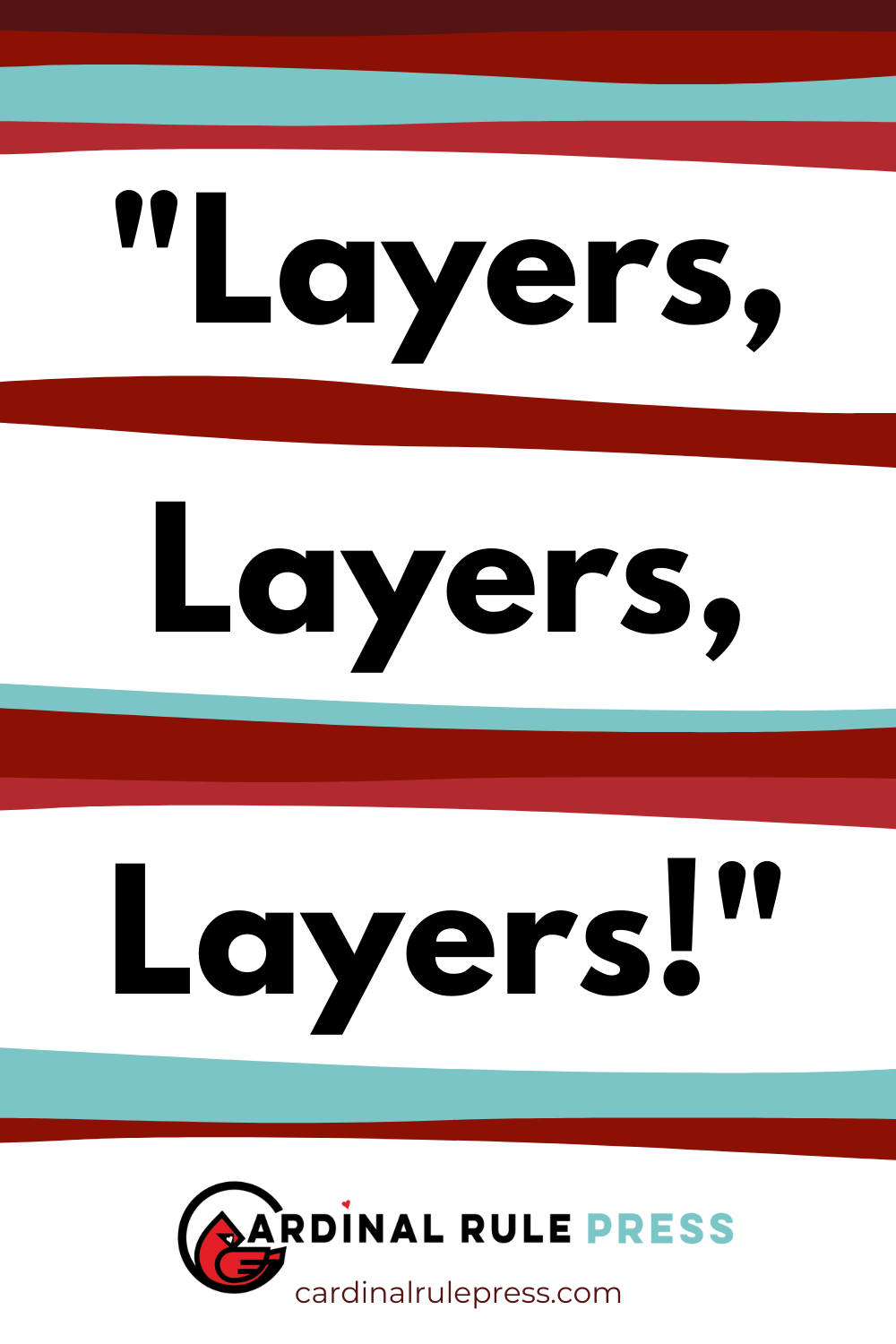
I’ve never been particularly good at layering.
This becomes a problem during the cold winter months (and February is DEFINITELY one of those!), but – hailing from Alabama – mercifully, I don’t have to deal with much cold. However, on rare biting-chill days, I will invariably forget a critical component. The tank top tucked tightly into my jeans. Or a cardigan thrown over my favorite top. Or some lined leggings to keep out chilly north winds. Layering insulates, adds interest, and…requires some thought.
“Should I wear this light pullover or a thick sweater?”
“Do I need something under this top?”
So when I found out that layering is critical for picture books?
First response – “Oh, no.”
Second response – “What do agents or editors MEAN when they say they want more layers? Surely not a tucked-in tank top? Or a second cozy sweater?”
As I unpacked what “layers” might mean in storytelling, I came across two other terms – 1) themes and 2) hooks.
1. THEMES
Adding more layers to your story might mean exploring more than one theme. Perhaps your character is longing for a friend and tries multiple ways to befriend another character? Besides friendship or how to be a friend, additional themes might be perseverance, tenacity, or reaching out to someone different. Open your favorite picture book and you’ll see that the ones you and your kids want to read over and over again are full of thematic surprises – new “finds” that make you think hard or see the world in a different way. For example, Evie’s Field Day by Claire Noland, published by Cardinal Rule Press, not only features fun field day games that most kids will recognize, but also introduces the themes of good sportsmanship and perseverance and dealing with disappointment.
Here are a few ways to explore themes and how to weave many together into a lovely pattern:
- Read, read, read! Go ahead, raid your local library and support your local bookstore! Stack those picture books (or other genre) up to the ceiling! But when you read, don’t simply read for speed, or to check that off your “list of things writers do,” or read purely for enjoyment. Sure, you can do those things, but remember to look for themes. What is the author trying to explore or teach or explain? Did she include multiple themes? How do you know what the theme is? Is it overt or hidden in the story?
- Many organizations for writers have some way to read and discuss books together. My SCBWI region hosts a “Picture Book Breakdown” where we can read and discuss one picture book for an hour. It’s a great way to evaluate what is working and what is not in already published books!
- Critique groups are invaluable when trying to tease out multiple themes in your picture book draft. If you haven’t yet, try joining a critique group and/or a professional writers group (like SCBWI or Julie Hedlund’s 12×12 challenge or Storyteller Academy). Check out Nikki Bergstresser’s post on the Cardinal Rule Press blog for all the benefits to engaging with other writers!

2. HOOKS
I haven’t been around the kidlit “block” for very long – relatively – but I can tell that editors LOVE hooks. When I first started reading interviews and listening to podcasts, I kept hearing about “multiple hooks.” I thought that HOOKS and THEMES were interchangeable, but as I listened more, read more picture books, and looked at more recent book deals, I began to see “hooks” differently.
When someone goes fishing, they take along multiple hooks and lures. Different fish like different food, after all. In the same way, different readers have different hobbies, passions, and interests. An outstanding book (picture book or other) will “fish” like a professional fisherman – with multiple hooks. Cookies and Milk by Michele McAvoy features the following hooks: science, sports, stunts, and being friends despite being different. If you take a closer look, you’ll probably find even more. Notice that the ones I listed are all featured on the cover!
Another way to think about a hook is something featured in the book, but not necessarily deeply explored or learned by the characters. In the book above, Cookie already LOVES science, while Milk LOVES sports. So kids who enjoy science and/or sports will appreciate finding characters who share their interests.
Some ways to “dive” for hooks –
If you haven’t listened to the “Picture Book Look” podcast by Kirsti Call and Kim Chaffee, it’s a gem and an excellent way to hear why editors acquired certain picture books. Spoiler: they often reference multiple “hooks”!
Crack the cover of your favorite picture book (or other genre) one more time. Just like themes, you’ll probably find multiple hooks that keep you turning pages.
Whether in the deep cold of winter or the long journey of writing, revising, and crafting re-readable books, layers are invaluable. Reading more picture books – and freezing when I walk out my front door – has made me take a critical look at my own picture book drafts…and my closet! Layers add interest, appeal to a broad base of readers, and keep pages turning. So, I hope you will fix yourself a warm drink and curl up with your favorite book…
…I’m going shopping. Gotta find more layers!
Don’t forget to download a free Storytime Planner from Cardinal Rule Press!
Heather C. Morris believes in the power of stories to inspire imagination and inform scientific discovery. She is a member of SCBWI and the 12×12 picture book challenge community. One of her picture book manuscripts was selected as a runner-up for the 2021 PBChat mentorship, and her short stories and poetry have appeared in multiple arts journals and anthologies. You can follow her on Twitter at @morrwriting and check out her “First Stories” series of author interviews on her website – heathercmorris.com.
Leave a comment